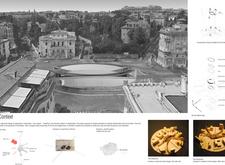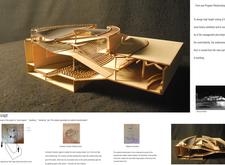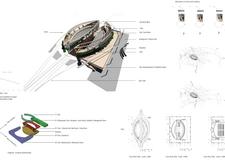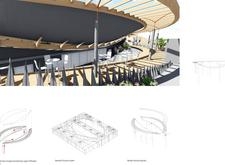5 key facts about this project
## Project Overview
The Nomentana project is situated in a prominent area of Rome, Italy, and responds directly to its urban context. Its design aims to create a harmonious relationship between architecture and the surrounding environment, addressing the needs of urban regeneration while reflecting the vibrancy of the Nomentana neighborhood.
## Spatial and Material Composition
### Design and Materiality
The project employs a distinct selection of materials that contribute to both functionality and aesthetic appeal. Wood is utilized for structural elements and interior finishes, offering warmth and tactile qualities. Concrete, used in perforated forms, facilitates light penetration and structural integrity, while extensive glass elements enhance transparency and light optimization. This layered combination generates a rhythmic interplay of curved forms and structured spaces, particularly exemplified by a floating concrete shading device that frames gathering areas and filters natural light throughout the day.
### Programming and Interaction
The arrangement of spaces across multiple levels is designed to encourage community engagement. A subterranean floor houses a reception area, historical exhibition space, and cafes, fostering local interaction. Above ground, public areas are organized to facilitate smooth movement, emphasizing both aesthetic appeal and functional utility with strategically placed entries. The auditorium features high ceilings to enhance visibility, supporting an immersive experience with curvilinear forms that symbolize unity and interaction among visitors.
### Network Creation and Sustainability
The design effectively establishes a network of public and private spaces that encourages casual interactions among users while delineating various areas through shaped forms and landscaping. Pathways integrated into the site promote connectivity with the surrounding urban landscape. Commitment to sustainability is evident in material choices and the inclusion of green spaces, fostering biophilic interactions that enhance the well-being of users while integrating nature into the urban environment.





















































